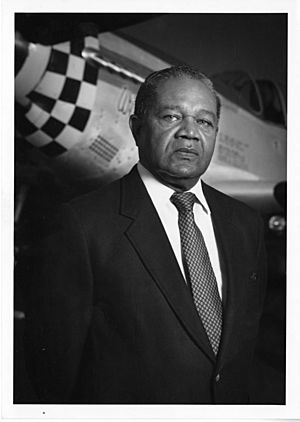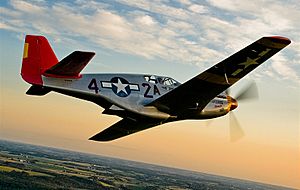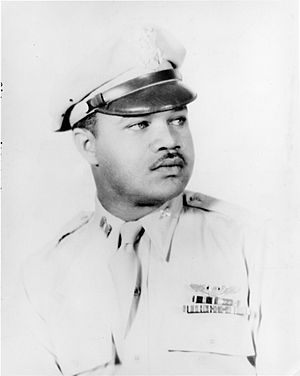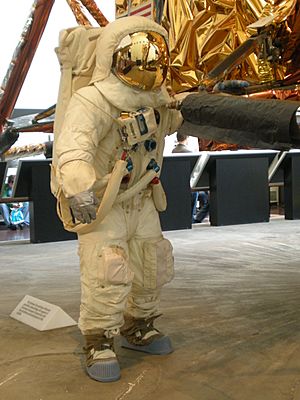Louis Purnell facts for kids
Quick facts for kids
Louis Rayfield Purnell, Sr.
|
|
|---|---|

Louis R. Purnell, Curator at NASM (c.1980)
|
|
| Born | April 5, 1920 |
| Died | August 10, 2001 (aged 81) |
| Nationality | American |
| Education | Lincoln University Tuskegee Institute George Washington University |
| Alma mater | Howard University |
| Occupation | Curator and Museum Specialist |
| Employer | National Air and Space Museum National Museum of Natural History |
| Spouse(s) | JoAnn |
| Children | 3 children |
| Military career | |
| Allegiance | |
| Service/ |
|
| Years of service | 1942–1945 |
| Rank | |
| Battles/wars | World War II |
| Awards | Distinguished Flying Cross Air Medal (6 Oak Leaf clusters) |
Louis Rayfield Purnell, Sr. (born April 5, 1920 – died August 10, 2001) was an important person at the National Air and Space Museum in the United States. He was a curator, which means he helped take care of and display museum items. Before that, he was a brave pilot known as a Tuskegee Airman.
At the museum, Louis Purnell became an expert on things related to space travel, especially spacesuits. He helped organize many exhibits about space exploration during the exciting years from the 1960s to the 1980s. He was also the first African-American person to become a curator at the famous Smithsonian Institution.
During World War II, he was a captain and fighter pilot in the Army Air Corps. He flew missions in Europe and North Africa. For his courage, he received special awards like the Distinguished Flying Cross and the Air Medal with six Oak Leaf Clusters.
Contents
Early Life and Dreams
Louis Purnell was born in Snow Hill, Maryland, on April 5, 1920. His father painted parts of train cars, and his mother was a teacher. He grew up in Wilmington, Delaware, and later in Cape May, New Jersey.
From a young age, Louis loved airplanes and flying. He would ride his bike to the local airfield to watch planes take off and land. When his family moved to a new neighborhood, his father gave him important advice: "to appear equal, you have to be twice as good." Louis remembered this advice throughout his life.
His interest in flight led him to study at Lincoln University. There, he earned his civilian pilot's license. This was a rare and impressive achievement for a Black man at that time.
Becoming a Tuskegee Airman
In the early 1940s, Tuskegee Institute had the only program in the U.S. that trained Black people in advanced flying skills. Louis Purnell applied and was accepted into this tough program. He said that two-thirds of the trainees didn't make it, but he succeeded.
Even though important people like Eleanor Roosevelt supported the program, the all-white Army Air Corps at first did not want to send Black pilots into battle.
In 1942, thanks to the efforts of other cadets and the National Association for the Advancement of Colored People, special all-Black Army Air Corps units were finally created. Louis Purnell became a captain and served in the 99th Fighter Squadron and later the 332nd Fighter Group. He flew 88 missions in North Africa, Sicily, and Italy. He protected bombers, even though he sometimes faced unfair treatment from other airmen.
After his first combat tours, Purnell returned to Tuskegee to teach flying. But he found combat "safer" and asked to go back to Europe. For his brave service, he earned the Distinguished Flying Cross and the Air Medal with six Oak Leaf Clusters.
Life After the War
After his military service, Louis Purnell went to Howard University and earned a degree in psychology. He worked as a speech therapist and later for the government.
In 1961, he was hired by the National Museum of Natural History. He studied geology and went on expeditions. He became very good at identifying ancient sea creatures called cephalopods and nautiloids, which he found "beautiful." However, some people saw his success as a threat, and he was unfairly passed over for promotions.
Working at the Air and Space Museum
In the late 1960s, Louis Purnell applied to work at the National Air and Space Museum. Unfair treatment related to his race kept him from joining the earth flight division. But in 1968, he was hired as a specialist in the Astronautics Department, which focused on space.
In 1969, humans landed on the moon, and the museum was planning its new building on the National Mall. In the early 1970s, Purnell finally became a curator. He became an expert in space travel items, especially spacesuits. He was the first African-American curator at the museum.
Louis Purnell was well-known for his work on the Spacecraft and Spacesuits exhibit. He helped expand and care for the museum's collections until he retired in 1985. When he retired, he gave his flying wings and other items from the war to the museum. He continued to work as a consultant and gave talks. Shortly before he passed away, a book he wrote the foreword for, Black Knights: The Story of the Tuskegee Airmen, was published.
Awards and Recognition
- Congressional Gold Medal awarded to the Tuskegee Airmen in 2006. This is one of the highest civilian awards in the United States.
See also
- Dogfights (TV series)
- Executive Order 9981
- Freeman Field Mutiny
- List of Tuskegee Airmen
- Military history of African Americans
- The Tuskegee Airmen (movie)




